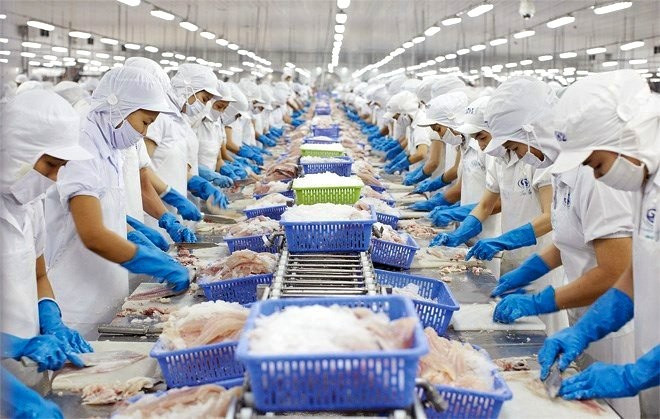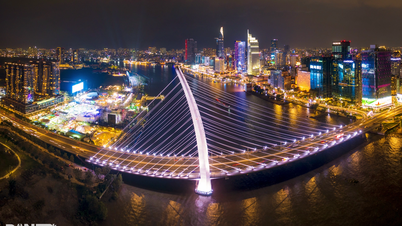
ADB leaders at the announcement ceremony. (Photo: Vietnam+)
The Asian Development Bank (ADB) forecasts Vietnam's economy will grow 6.6% in 2025 and 6.5% in 2026, after reaching 7.1% growth in 2024.
This assessment was made by ADB in the Asian Development Outlook (ADO) report released on April 9.
While maintaining a positive outlook for Vietnam this year and next, the ADO April 2025 report also highlighted risks to the growth outlook, and these forecasts were calculated before the US announced tariff measures on April 2.
Retail, tourism, FDI are bright spots
ADB experts forecast the services sector to grow by 7.2% in 2025, driven by increased domestic and international tourism and technology industries. Nearly 4 million international visitors arrived in Vietnam in the first two months of the year, up 30.2% year-on-year. Facilitated visa procedures, tourism promotion programs, and international recognition have fueled this growth.
The government’s focus on digital transformation and sustainability will open up new opportunities, particularly in financial services and retail. However, the services sector remains exposed to global economic uncertainties, despite ongoing reforms. Despite rising global tariffs, demand for agricultural commodities and free trade agreements will help sustain exports.
Agriculture is expected to continue growing steadily at 3.2% in 2025, but climate change, limited access to technology, and infrastructure gaps remain challenges for the sector, according to ADB experts. Improving productivity through technology and managing rising global tariffs while maintaining competitive prices are key to sustaining export growth.
Retail sales are growing, supported by monetary and fiscal measures. In February 2025, retail sales increased 9.4% compared to the same period in 2024, but still below expectations. The government is targeting a 12% increase in retail sales and consumer services revenue in 2025. However, 67,000 businesses ceased operations in the first two months of 2025, up 7.0% from a year earlier, reflecting the challenges faced by businesses despite strong consumer demand.
Mr. Nguyen Ba Hung - ADB economist said that Vietnam's inflation is forecast to remain stable at 4% this year and increase to 4.2% next year. The two driving forces for Vietnam's economic growth in the next two years are still abundant foreign direct investment (FDI) and stable retail sales.

International tourists to Vietnam. (Photo: Vietnam+)
Before the US had a specific tariff policy, Vietnam was still an attractive destination for FDI. However, US tariffs will affect this factor.
"When quantitative factors are still unclear, investors' natural reaction is to stop and wait for new decisions. Their waiting and listening will slow down the speed of FDI disbursement," Mr. Hung commented.
Data shows that retail sales are relatively stable, helping Vietnam's GDP grow steadily. For the economy to grow rapidly, domestic demand needs to be stimulated more strongly, Mr. Hung added.
What challenges does Vietnam face?
According to ADB experts, global trade tensions could impact export-oriented manufacturing. The global economic environment, with rising trade conflicts and geopolitical tensions, could have a significant impact on export-oriented manufacturing. The return of protectionist policies under the new US administration could reduce global demand for products made in Vietnam, especially given the large trade surplus with the US.
The global economic landscape is volatile, affected by US tax policies, geopolitical tensions, including the Russia-Ukraine conflict and instability in the Middle East. Along with that is the slowing growth in the US and China - two major trading partners of Vietnam. These factors may adversely affect Vietnam's economic prospects in the coming time.
Assessing the impact of the new tariff measures announced by the US on April 2 on Vietnam, Mr. Shantanu Chakraborty - ADB Country Director for Vietnam noted that the forecast figures in the ADO report were completed before the US announced these measures. Since the event is still evolving and the full details are not yet clear, it is too early to accurately estimate the quantitative impact on Vietnam's economic growth.

Exports may be affected by US tariffs coming into effect. (Photo: Vietnam+)
However, Mr. Chakraborty said that a country's relative competitiveness depends not only on tariffs, but also on many other factors. Therefore, a comprehensive view is needed when assessing the impact of the new policy.
“The Vietnamese government has set ambitious growth targets, which can help mitigate external risks significantly. Higher and more sustainable economic growth can be achieved if the comprehensive institutional reform efforts over the past period are implemented quickly and effectively. These reforms will stimulate domestic demand, improve the efficiency of state management in the short term, and thereby promote private sector development in the medium to long term,” said Mr. Chakraborty.
Increasing Vietnam’s participation in global supply chains is a key policy challenge for the country’s development, according to ADB experts. As global economic dynamics change, so too will Vietnam’s advantages in increasing value addition in global supply chains.
"Understanding the constraints and challenges associated with expanding Vietnam's participation and increasing its value addition in global supply chains is critical to improving the country's economic development trajectory and long-term growth potential," the ADB leader recommended./.
(Vietnam+)
Source: https://www.vietnamplus.vn/adb-kinh-te-viet-nam-gia-tang-suc-manh-truoc-nhung-thach-thuc-toan-cau-post1026667.vnp





![[Photo] General Secretary To Lam presents the title "Hero of Labor" to the Party Committee, Government and People of Ho Chi Minh City](https://vphoto.vietnam.vn/thumb/1200x675/vietnam/resource/IMAGE/2025/4/30/08a5b9005f644bf993ceafe46583c092)

![[Photo] Flag-raising ceremony to celebrate the 50th anniversary of the Liberation of the South and National Reunification Day](https://vphoto.vietnam.vn/thumb/1200x675/vietnam/resource/IMAGE/2025/4/30/175646f225ff40b7ad24aa6c1517e378)



























![[Photo] Demonstration aircraft and helicopters flying the Party flag and the national flag took off from Bien Hoa airport](https://vphoto.vietnam.vn/thumb/1200x675/vietnam/resource/IMAGE/2025/4/30/b3b28c18f9a7424f9e2b87b0ad581d05)




























































Comment (0)